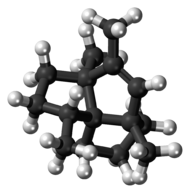 | |
 | |
| Names | |
|---|---|
| IUPAC name (3aS,5aS,8aR)-1,3a,4,5a-Tetramethyl-1,2,3,3a,5a,6,7,8-octahydrocyclopenta[c]pentalene | |
| Identifiers | |
3D model (JSmol) | |
| ChemSpider | |
PubChem CID | |
| UNII | |
CompTox Dashboard (EPA) | |
| |
| |
| Properties | |
| C15H24 | |
| Molar mass | 204.357 g·mol−1 |
Except where otherwise noted, data are given for materials in their standard state (at 25 °C [77 °F], 100 kPa). | |
Isocomene is a sesquiterpene first isolated from the perennial herb southern goldenbush ( Isocoma wrightii ), [1] from which it derives its name. Its unusual structure consisting of three fused cyclopentane rings was first described by Zalkow et al. in 1977. [1] The first total synthesis of isocomene was published by M.C. Pirrung in 1979. [2] The key steps are a photocatalyzed intramolecular [2 + 2] cycloaddition reaction followed by a rearrangement reaction which forms three contiguous chiral centers. [3]